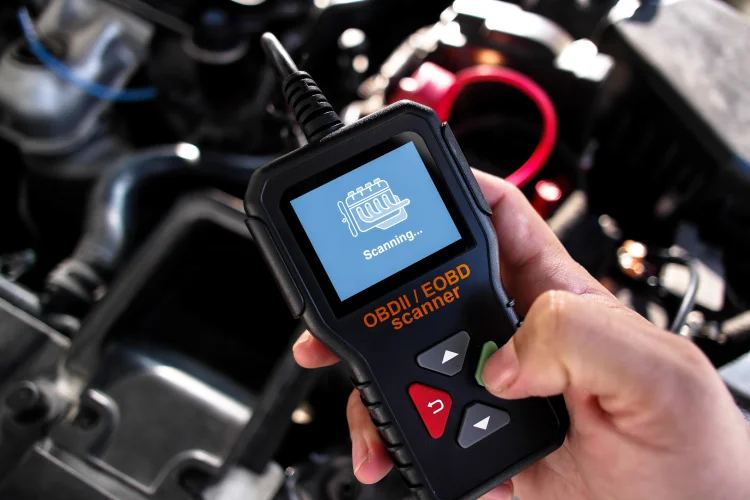What Is an OBD-II Scanner and How Does It Work?
OBD-II Scanner
5,683If you've ever seen your car’s check engine light turn on and wondered what’s going wrong, you're not alone. That little warning light can signal dozens of potential issues—but thankfully, there’s a tool that can help decode the mystery: the OBD-II scanner.
Whether you’re a weekend DIYer or just want to avoid a costly trip to the mechanic, understanding what an OBD-II scanner is (and how to use it) can save you time, stress, and money.

What Is an OBD-II Scanner?
OBD-II stands for On-Board Diagnostics, Second Generation. It's a standardized system found in most vehicles made after 1996, designed to monitor your engine and other key systems.
An OBD-II scanner is a device that connects to your vehicle's OBD-II port and reads the diagnostic trouble codes (DTCs) your car's computer generates when something goes wrong.
In simple terms? It’s like a translator between your car’s brain and you.
What Does an OBD-II Scanner Do?
An OBD-II scanner can:
-
Read and clear diagnostic trouble codes (DTCs)
-
Display real-time sensor data (RPM, fuel pressure, air/fuel ratio, etc.)
-
Monitor emissions system readiness
-
Provide freeze frame data (snapshot of sensor readings when a fault occurred)
-
Help identify the root cause of check engine lights and performance issues
Some advanced models can also:
-
Test your vehicle’s battery or charging system
-
Reset certain systems (like oil change reminders or TPMS warnings)
-
Connect to your smartphone via Bluetooth or Wi-Fi for more detailed reporting
Where Is the OBD-II Port Located?
In most cars, the OBD-II port is found:
-
Under the dashboard, near the driver’s seat
-
Usually within 2 feet of the steering wheel
-
Sometimes behind a small plastic cover
Look for a 16-pin connector—that's your OBD-II port.
Types of OBD-II Scanners
There are two main types of scanners:
1. Code Readers
These are basic devices that:
-
Read and clear codes
-
Show limited data
-
Often cost less than $50
2. Scan Tools
More advanced and typically used by mechanics:
-
Display live data from multiple systems
-
Offer graphing and freeze frame functions
-
May support manufacturer-specific codes
-
Can cost from $100 to several thousand dollars
Why Should You Own an OBD-II Scanner?
✅ Diagnose Issues Early
Catch minor issues before they become major repairs.
✅ Save Money
Clear simple codes yourself (like a loose gas cap) and avoid unnecessary shop visits.
✅ Gain Insight
Understand what’s going on under the hood—no guessing involved.
✅ Improve Confidence
Whether you're buying a used car or troubleshooting your daily driver, an OBD-II scanner gives you knowledge and power.
How to Use an OBD-II Scanner (Basic Steps)
-
Plug it in: Insert the scanner into the OBD-II port.
-
Turn on the ignition (don’t start the engine).
-
Wait for the scanner to boot up and follow on-screen prompts.
-
Read codes: You'll see alphanumeric codes (like P0171).
-
Interpret codes: Use the scanner's built-in definitions or look them up online.
-
Clear codes (optional): After fixing the issue, you can clear the code and reset the light.
Learn More & Shop with Confidence
| Category | Recommendation | Why It Matters |
|---|---|---|
| Basics & How It Works | MotorTrend – What Is an OBD2 Scanner and How Does It Work? | A clear, beginner‑friendly explanation of OBD‑II functionality and diagnostic uses. |
| Budget Comparison | Foxwell Diag – Cheap vs. Expensive OBD2 Scanners | A helpful breakdown of what features you get (or miss) at various price points. |
| Pro‑Level Buying Guide | Total Car Diagnostics – Ultimate Guide to OBD‑II Scanners | In‑depth look at features like live data, system coverage, and compatibility. |
| Top Picks for Every Budget | Tom’s Guide – Best OBD‑II Scanners in 2025 | Suggestions ranging from affordable models like the Launch CR529 to premium tools like the Topdon Phoenix Lite 2. |
| Best Budget Option | Outdoor Moran – Ancel AD310 Review | A reliable, mechanic‑endorsed everyday scanner that won’t break the bank. |
| Recommended Brand‑Specific Tool | Scotty Kilmer / The Sun – Launch Elite Toyota Scanner | A specialist pick for Toyota/Lexus owners with near‑dealer functionality under $120. |
Final Thoughts
An OBD-II scanner is a must-have tool for anyone who owns a car. It demystifies your vehicle’s warning lights, empowers you to make informed decisions, and can even help you avoid unnecessary repair bills.
Whether you go for a $30 Bluetooth scanner or a pro-level scan tool, this device is your best friend when the check engine light comes on.
TL;DR: Curious about that little port under your dashboard? It connects to an OBD‑II scanner—a powerful tool that reads your vehicle’s trouble codes and sensor data. Learn what an OBD‑II scanner is, how it works, the different types, and how it can save you time and money when your check engine light comes on.
— Robert Vaughn
